On Wednesday, I met with Ginsu Linden (a.k.a. Ginsu Yoon – photo on the the left from Joi’s Flickr stream) to talk about Second Life’s global role.
Ginsu Linden is Linden Lab’s vice president, business affairs – generally overseeing international market development, business and corporate development, and developer programs.
Ginsu was in Asia when we met on the pontoon at Aleister Kronos’s quiet seaside retreat on Second Life, where sculpted prim icebergs sparkle among the palms. Aleister is a well known Second Life blogger and Senior Enterprise Architect in Real Life. He is also a Second Life artist. He spends some of his time quietly pottering around in his lovely sculpture garden, fine tuning his creations.
Once seated opposite Ginsu in this quiet corner of the metaverse, the sound of the waves lapping in the background, the continents between us seemed to vanish.
I know that those of you already familiar with immersive worlds already understand how compelling they are in ways that are very personal and hard to quantify. But, it is a very difficult to transmit this to people who haven’t experienced it.
The social/immersive qualities of virtual worlds tap into ranges of human experience and modes of expression beyond text and speech. This is one of the key contributions virtual realities make to new forms of global communication.
The only immersive virtual space (for the moment at least) that allows for the full user created expression of entire cultures or personal identities is Second Life.
“Second Life is so immersive that it can transmit more than just text. It can transmit entire cultures” (Ginsu Linden)
I asked Ginsu a number of questions on several topics including: When are Linden Lab’s open sourcing the servers and/or setting up server farms outside the US? What were his thoughts about the intersection of virtual worlds and mobile space? How would virtual worlds create new channels of global commerce? But, it was the clear to me, the most important understanding I took from the interview was not just answers to questions on issues of scaling, open sourcing, virtual commerce and the guiding principles behind Linden Lab’s global provider program. Rather, I gained a better overall sense of how virtual worlds could come of age as a truly positive global phenomena. While commerce may well be the driving force in the development of virtual worlds and Second Life, it is the non-commerce related experience of virtual worlds that is really something to write home about. Ginsu made the point clearly:
I think that there’s a good argument to be made for the value of non-commerce related experience in SL.
It’s really interesting to watch digital cultures spread in SL, and this is not something that is closely tied to a virtual economy…. it’s great to watch people in different countries interact in SL.
People always make the comparison of SL to a 3D web, but one of the things that is quite different is that on websites today, you do not see people from different countries interacting much.
People on the Internet tend to stay within their own cultures, because websites are still primarily a text-based medium.
But SL is so immersive that it can transmit more than just text, it can transmit entire cultures. So you see this very interesting effect where people from other countries are quite eager to interact with each other, similar to the way people are quite keen to travel if they have the opportunity.
Argentonia
Ginsu’s remarks resonated strongly with an experience I had doing a little tourism on Second Life just recently. I met, and spent some time with Dmian (pictured above), who showed me around the new Argentonia sim. I had come to find out about the virtual elections to be held there. They were blogged by Pablo Mancini. But, after meeting Dmian, not only did I get an insider view on the elections both in Real Life and Second Life, but I experienced a taste of the Buenos Aires music scene. Dmian Munro has started a virtual band in Second Life. Please check out his video blog and myspace.
There is much more to say about this experience and Argentonia, so I will return soon. But, please see the Argentonia blog and this video to get the flavor of a mixed reality event Argentonia style. I mentioned Argentonia to Ginsu. And, he said he had not heard about this sim yet. Second Life is expanding so fast no-one, not even a God can keep up!
Linden Lab’s Global Provider Program
I asked Ginsu what he thought it was about Second Life that makes SL more pervasive, or even Web 3D.
Ginsu replied:
This is just my opinion – in each country, the best efforts will really be made by local providers who will build locale-appropriate content on the Second Life grid. I would not say that SL has to be “more” or a “replacement” for anything. People are always obsessed with declaring something else dead. But look at the media landscape today – oral tradition, books, plays, radio, TV, movies, Internet – each of these things was supposed to be the “death” of something else – and yet we still enjoy all of them.
I asked Ginsu whether when he said local provider he meant the Kaizen model. Kaizen has recently launched Second Life Brasil:
Yes, Kaizen is the first to launch in the global provider program.
I continued: “And, what has made them successful?”
First of all, they are very committed to the effort and willing to move quickly and flexibly. They have spent a lot of time understanding their goals in SL, and have built their own tools to manage their efforts.
I have always believed that it is folly for anyone to believe that a company in SF is going to know what everyone around the world wants. The likeliest source for local product is local providers.
“How do you feel Linden Labs are giving Global Providers maximum autonomy and the benefits of being on the Second Life grid? Are there lag problems from the server farms being so far away?”
I think the point of SL as a service platform is that it should be maximally configurable to the needs of the local provider. There can be several local providers in a single market, they can compete on their services and configurations, let the market decide what works. Yes, local servers would improve some aspects of performance. That’s a frequent request and one which we’d like to satisfy. Like anything, it takes some work to accomplish.
“And you can satisfy that before LL goes open source right? The two are not mutually dependent?” I asked.
I don’t think the two are mutually dependent.
Right at the beginning of our conversation, I asked Ginsu when Second Life would go open source server side. I sort of blurted the question out the minute I saw him hoping, of course, for a major Ugotrade scoop! And, he said:
We have generally announced our ambition to open source server code. However, this is in the speculative stages and I can’t commit to any time-line yet.
Certainly we think open sourcing server code would be a very compelling way to spread SL.
There are many people who said we would never open source the client. I suppose if you look at our track record, it sometimes takes us quite a while to deliver on our ambitions. However, I think it would be unfair to say that we don’t try to achieve what we’ve promised.
Oh well, I was a little disappointed not to rock the blogosphere with some big news. But, maybe next time!
Since the interview I have spent some time thinking about the global provider program and trying to understand more about it. It is clear that even key Second Life movers and shakers find it less than self evident.
Second Life Portugal?
Gwyneth Llewelyn, important metathinker on Second Life, and Business Manager of Beta Technologies had a number of comments when I asked her about the global provider program:
Well… the issue that we ask is: why a “global provider program” at all? The client can be tweaked easily (it already supports Portuguese by default) The registration API already allows you to create whatever accounts you wish, from your own website, and you can have avatars dropping on “your” island. So… what this program gives you, is mostly a discount on islands (negligible — people like Anshe Chung get better) and being allowed to use LL’s “Second Life” logo, with some restrictions, on the site. As for how successful Kaizen is, I have no idea, but they surely have a HUGE continent!! …… That’s why we’re being careful ourselves… we don’t want to be “SL Portugal” unless we understand what that means (it’s not our core business, although we have the means to do that if we think it’s worth it
)
What this will allow is providing added value ie. customer support
and targeted content towards specific communities. In essence, what Anshe (and so many others) have been doing for years now.
This is only a tiny snippet of what Gwyn had to say on this issue. She made many astute observations on this and other key debates re the growth of Second Life, including the hot issue of the interpretation statistics. If Gwyn doesn’t write up the rest of these observations herself, I will in a later post! Gwyn has a fascinating post up at the moment on the growth of Second Life in Portugal and the recent conference on Second Life held locally, at the University of Aveiro, 1º Workshop on Communication, Education and Teaching. This is a must read for all interested in education, culture, and commerce on Second Life. Gwyn notes:
people [in Portugal] are getting their master’s thesis and doctorates in Second Life. Very surprising for a country which practically just had one representative (Eggy Lippmann) for a couple of years and still has only 50.000 users on SL today — many of which quite recent, as the Portuguese media just “woke up†to Second Life less than half a year ago.
Here’s Jorge Lima a.k.a. Eggy Lippmann.
I also chatted with Aleister Kronos and Veejay Burns about the Global Provider program. And, Aleister did have some thoughts. Veejay was exhausted after a long day in Real Life and retired early. I will let him break the interesting news about what he accomplished in RL! Aleister blogged Kaizen for 3pointD.
The three of us could see some special features that Kaizen offered Brasilian Second Lifers. For starters, you can’t buy L$ thru Linden Lab using Brazillian Reals, but you can through Kaizen. Although there has been some concern in the blogosphere about this. Meta Bronca wrote: “Many users felt wronged by the potential currency exchange monopoly established by the partnership IG-Kaizen.”
The blogosphere seems well overdue for a post (is there already one I don’t know about?) on the state of virtual currencies, and the global implications of their development.
Al pointed out that Kaizen actually gives IT support to a Second Life viewer also. Anshe Chung, The Electric Sheep Company and others have created portals, but do not supply a modified viewer. If there is a bug in the viewer a Brasilian reports it to Kaizen. So Kaizen is an IT service too.
The Linden Lab Global Provider program is just starting out, so I am sure we will be hearing more about it in the future.
Second Life Africa?
Ginsu Linden mentioned that Linden Lab has interest from several countries in Europe and Asia. I was disappointed not to hear Africa on the list yet. But, after reading this post Ginsu sent this encouraging message:
We actually have gotten inquiries from Africa as well. It’s been busy here.
I picked up a story on Ugotrade from Mutumwa Mawere. Mawere writes in his column in Zim Daily about the benefits virtual worlds in general, and Second Life in particular, might bring to Africa. And, I recently read an interesting post on African Computer Game Development. In particular, Africa the MMORPG a project reportedly in limbo seems very interesting.
Some Cool Upcoming Second Life and Mixed Reality Events.
From Keystone Bouchard:
June 14, 10AM PST Chris Luebkeman : Future Challenges: Global Creative Contexts
Population shifts, increasing scarcity, and the wanton consumption of arable land and natural (renewable and nonrenewable) resources amount to what could prove to be a significant global dilemma – a dilemma of disastrous proportion. Yet trends in design and an ever-increasing focus on conservation and environmental issues suggest that we are headed for a collective change. This program considers the impact of global drivers of change on sustainable creative contexts, explores potential implications, and provides attendees with examples of design work that is already responding to the challenges.
Attend this event on Autodesk Island HERE (SLurl).
Also see the Autodesk press release.
Sergio Palleroni and Phil Bernstein on Architectural Sustainability last Thursday on Autodesk Island.
Check out Clear Night Sky for the discussion Sergio Palleroni and Phil Bernstein gave on Autodesk Island.
And in New York City!
For more see The Cruxy Blog.
I spent some time hanging out in the Cruxy Sky Box on Second Life yesterday. It was a lot of fun. And, I saw how Second Life may well be becoming THE happening place for hip bands to express themselves. I have to admit I haven’t been paying enough attention on this front. And, just a few of the things that Nat Mandelbrot mentioned in my short visit re creating experiences around the music in Second Life, e.g., fan made music video and reinventing “album art,” got my imagination firing. I will post more on this.



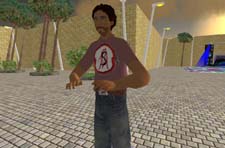
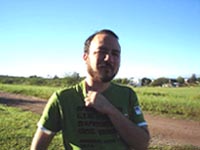




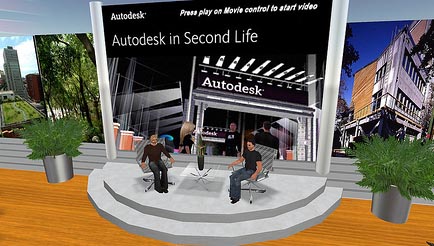
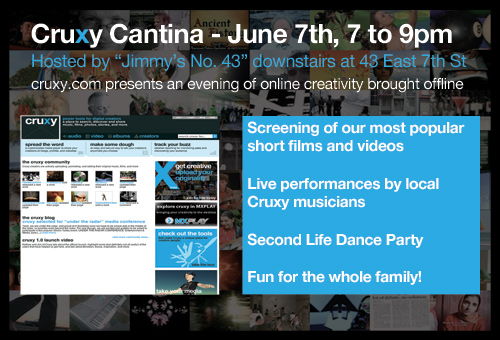
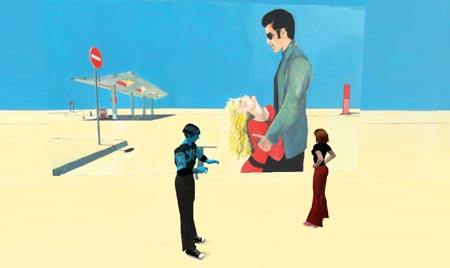
June 1st, 2007 at 10:07 am
I’m pleased you enjoyed the ambiance of New Alville – which will remain a perpetual work in progress (and will never appear on a Linden Search!). My purely personal aim is to provide a space for myself and friends to meet and chat in a relaxing, amusing environment.
Thanks for the kind words and – as you already know – you are always welcome.
June 3rd, 2007 at 4:50 am
The interesting aspect is that Second Life, so far, has been an international environment where the national borders were secondary (timezones are important; language and culture not so much). It seems to be moving towards being, as you said, a “global” environment, but in a different form: instead of having an international audience sharing the same space, it becomes a cluster of local/national regions, each with a language and culture, but sharing the same environment.
The distinction is sometimes blurry and hard to find, but the same happened to the Internet, as people moved from a mostly English-speaking metaculture to locally produced content; China’s own Baidu search engine is one of the top ten sites in the world (according to Alexa) although it practically only searches Chinese content, something that would be unthinkable a decade ago.
June 4th, 2007 at 5:58 am
Picking up on Gwyn’s comments…
We are already seeing this localisation of cultures in SL, largely driven (understandably) on language boundaries. In fact, this localisation has been a feature for as long as I have been a resident (OK – far less time than Gwyn, but still over 9 months).
There have been substantial German communities for a long time, and significant Dutch communities are now catching up. The influx of Brazillians in late 2006 saw a number of Brazillian communities establish themselves – indeed, these are among the most active and vibrant in SL. And this greatly predates the Kaizen “outsourcing”. That said, it has also identified a need for a Portuguese-friendly access point into SL to tap into a large and enthusiastic market – a need now met by Kaizen.
In my travels in SL I am also struck by the huge numbers of Japanese sims, many of them brand new or only a few months old. I have not yet got to the bottom of this, since Japan currently represents only a tiny fraction of SL users. Is there an anticipated surge in Japanese takeup of SL? I watch and wait with interest.
July 2nd, 2007 at 1:09 pm
Fascinating. Now if I can just figure out how to use — I’m registered as Laurel Barthelmess — Second Life, I’ll be a happy globetrotting gal!